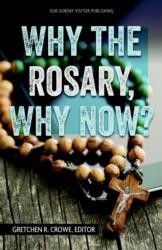WASHINGTON (CNS) — Why do Catholics pray the rosary?
The history of the rosary traces to the 13th century. It is believed that Mary gave St. Dominic the rosary to rescue the church from the Albigensian heresy.
(See a related video.)
Initially, 150 Hail Marys were prayed as a part of the rosary.
“The prayer of the rosary, originally composed of 150 Hail Marys, is based on the 150 psalms of the Psalter prayed in monasteries since antiquity,” said Gretchen Crowe, editor-in-chief of OSV Newsweekly in Huntington, Indiana, and author of the new book “Why the Rosary, Why Now?”

Gretchen Crowe
(CNS photo/courtesy OSV Newsweekly)
The string of beads used to recite Our Fathers and Hail Marys are called “paternosters,” Latin for “Our Father.”
The rosary evolved over the next three centuries to consist of 50 beads — which form the five sections, or decades, of the rosary, separated by a large bead for the Our Father.
“In many ways, the rosary and its spiritual benefits became most well-known during the 19th and 20th centuries through the record 11 encyclicals Pope Leo XIII wrote on the topic,” Crowe said.
In addition to Pope Leo XIII and his writing, the rosary increased its popularity when St. John Paul II added the luminous mysteries in 2002.
The luminous mysteries are one of four mysteries for the rosary and are known as the mysteries of light. The other three are the glorious, joyful and sorrowful mysteries. The mysteries recited different days of the week.
“The division into the mysteries of the life, death and resurrection of Jesus are part of the gift of the Dominicans to the universal church and in the recent past by St John Paul II who gave us the Luminous Mysteries to ponder,” said Conventual Franciscan Father Jude DeAngelo, chaplain and director of campus ministry at The Catholic University of America in Washington.
[hotblock]
Crowe explained that Catholics say the rosary to become more connected to Jesus Christ through his mother, Mary.
“This happens through meditating on the mysteries of the rosary — the joyful, sorrowful, luminous and glorious — while praying each decade,” Crowe said. “The more deeply we understand the incarnation, death and resurrection of Jesus, the more we will be able to align our lives with his will.”
The prayer’s mysteries use Scripture as a way to connect each bead to a passage from the Bible. When the rosary is recited this way, it is called the scriptural rosary. As an example, the sorrowful mysteries tie to Scripture readings from Isaiah, Wisdom, Psalms, Lamentations, Matthew, Luke and John.
Crowe believes the prayer is great for kids to say with their family.
“It’s a simple prayer, easily memorized, ideal for group or individual praying while on the go or sitting still,” Crowe said. “Its simplicity also allows for families to easily pray the prayers together, with young children even able to lead.”
 There are numerous ways to pray the rosary and why people do it. Father DeAngelo describes the prayer as a way to walk in the footsteps of Christ.
There are numerous ways to pray the rosary and why people do it. Father DeAngelo describes the prayer as a way to walk in the footsteps of Christ.
“The rosary is a beautiful way to meditate on the life, death and resurrection of Jesus and the honored place of Mary in salvation history,” Father DeAngelo said. “As the first disciple of Jesus, Mary helps each Christian to walk in the footsteps of Jesus and respond to the Father’s will in each person’s daily life just as she did.”
Oct. 7 is the feast of the Holy Rosary. It marks the naval victory at the Battle of Lepanto by Don John of Austria over the Turkish fleet on the first Sunday of October in 1571. On that same day, the pope in Rome told the faithful to say the rosary for a victory in the battle.
For many Catholics, the rosary is a shield of protection during times of need. Crowe said that it can help with life’s struggles.
“Holy men and women throughout the history of the church have testified to its great power,” Crowe said. “In today’s world, praying the rosary can help us combat some of the most difficult contemporary struggles.”
Using the prayer during times of need can turn rough moments into signs of good news. Crowe says that it provides comfort and strength.
[hotblock2]
“It also can help us achieve peace in the world, grow in discipleship and love of the church, and grow in holiness,” Crowe said. “The rosary is a prayer beloved by Catholics, who for centuries have found comfort and strength in speaking to the Blessed Mother with the help of their strands of beads.”
With growing popularity among youth in colleges across the country, it is not uncommon to find stories of people who love saying the rosary.
Victoria Conaway, a recent graduate of The Catholic University of America, has been praying the rosary regularly since high school.
“On a mission trip, I started praying it every day,” Conaway said. “It just became a habit to pray it every day.”
Since that high school mission trip, she has tried to dedicate two to three times per week for praying the rosary. She has seen the impact of prayer help her adjust to a busy schedule in college
“Setting aside time for any type of prayer will have a positive impact in your life,” Conaway said. “Especially the times you think you don’t have the time to pray are the times you need it the most.”
Conaway said she had an impressive experience when she was at World Youth Day in Poland last year.
“My group went to Auschwitz and we were walking through the concentration camp and we were all having a hard time with it so our bishop asked us if we wanted to pray a rosary,” she told CNS. “As we were walking through and I was praying this prayer and I said the words, ‘Lead all souls to heaven, especially those in most need of thy mercy.’
“I realized that I wasn’t necessarily praying for those who had died there, but for those who had committed these atrocities,” said Conaway. “It was really profound for me to realize that those people also deserve our mercy and Christ’s mercy and that’s why he came to save us.”
PREVIOUS: Viewers of ‘All Eyez on Me’ might want to avert their ears
NEXT: ‘Transformers: The Last Knight’ morphs into boredom, confusion



Share this story